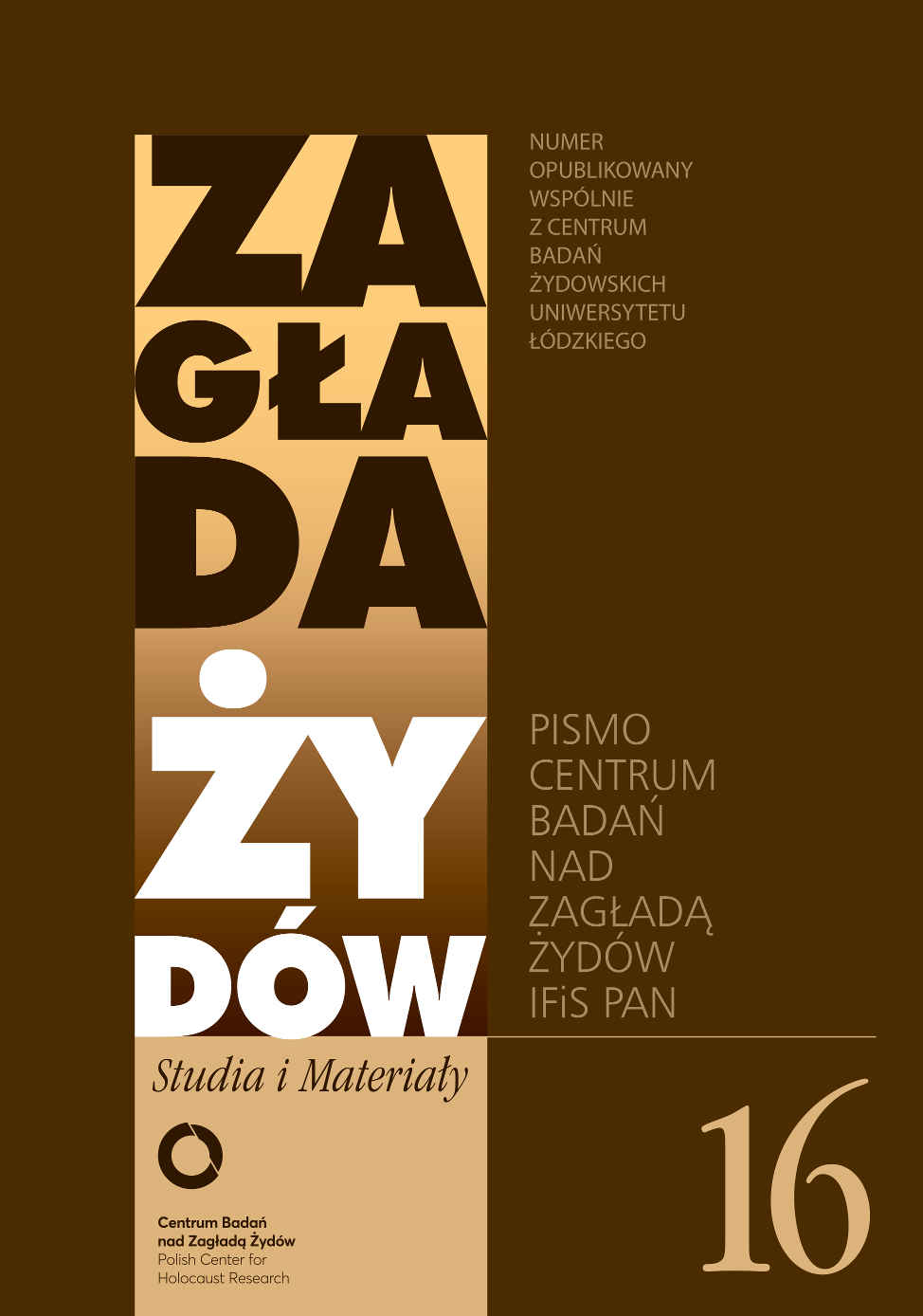Ruch hachszarowy w getcie łódzkim 1940–1941 w świetle dokumentów.
Zagłada Żydów. Studia i Materiały, Nr 16 (2020), Strony: 55-82
Data zgłoszenia: 2020-11-06Data publikacji: 2020-12-16
 https://doi.org/10.32927/zzsim.644
https://doi.org/10.32927/zzsim.644
Abstrakt
Artykuł jest poświęcony funkcjonującym w pierwszych miesiącach istnienia getta w Łodzi hachszarom. Na terenie Marysina, w opuszczonych gospodarstwach rolnych, latem 1940 r. powstało kilkadziesiąt grup skupiających młodzież żydowską. Formalnie zostały włączone do Wydziału Rolniczego działającego w ramach administracji żydowskiej getta. Podzielono je na dwie grupy, różniące się oznaczeniem: literowe gromadziły osoby związane z organizacjami syjonistycznymi chalucowymi (szykujące się do roli pionierów w Palestynie), natomiast do oznaczonych cyframi rzymskimi należała młodzież z bardzo różnych środowisk. Grupy, określające się w dokumentach jako kibuce, kierowane przez wybierane przez siebie zarządy, organizowały pracę w przynależnych do zajmowanych budynków gospodarstwach oraz prowadziły aktywność kulturalną i sportową. Samodzielność funkcjonowania tych grup zmalała późną jesienią 1940 r. Oprócz konfliktów wewnętrznych czynnikiem wpływającym na upadek ruchu hachszarowego była pogarszająca się sytuacja w getcie (rosnące niedobory żywności) oraz konieczność organizowania resortów pracy, do których kierowana była młodzież z Marysina
Słowa kluczowe
getto łódzkie , organizacje młodzieżowe , ruch hachszarowy , kibuce młodzieżowe , administracja żydowska w , przymus pracy
Bibliografia
Źródła archiwalne / Archival sources
Google Scholar
Archiwum Masua
Google Scholar
-4/120, Relacja Josefa Wassercyjera
Google Scholar
Archiwum Moreszet, Bejt Edut al szem Mordechaj Anielewicz
Google Scholar
D.1.242-239
Google Scholar
Archiwum Państwowe w Łodzi (AP Łódź)
Google Scholar
zespół Przełożony Starszeństwa Żydów
Google Scholar
Archiwum YIVO Institute for Jewish Research w Nowym Jorku (AYIVO)
Google Scholar
RG 241, Kolekcja Nachmana Zonabenda
Google Scholar
Archiwum Żydowskiego Instytutu Historycznego w Warszawie (ĄŻIH)
Google Scholar
, Relacje Żydów Ocalałych z Zagłady
Google Scholar
Publikacje / Publications
Google Scholar
Chirurg Riva, Bridge of Sorrow, Bridge of Hope, California: Judas L. Magnes Museum, 1994.
Google Scholar
Dziennik Lolka Lubińskiego, oprac. Anna Łagodzińska, Łódź: Muzeum Historii Miasta Łodzi, 2014.
Google Scholar
Frenkiel Jezechiel, Teatr i inna działalność artystyczna w getcie łódzkim w latach 1940–1944, [w:] Łódzkie sceny żydowskie, red. Małgorzata Leyko, Łódź: Wydawnictwo UŁ, 2000.
Google Scholar
Kronika getta łódzkiego / Litzmannstadt Getto 1941–1944, red. Julian Baranowski i in., Łódź: Wydawnictwo UŁ i Archiwum Państwowe w Łodzi, 2009.
Google Scholar
Kwiatkowska Rywa, Działalność młodzieżowych organizacji chalucowych w getcie, „Biuletyn ŻIH” 1965, nr 2 (54).
Google Scholar
Löw Andrea, Getto łódzkie / Litzmannstadt Getto. Warunki życia i sposoby przetrwania, tłum. Małgorzata Półrola, Łukasz Marek Plęs, Łódź: Wydawnictwo UŁ, 2012.
Google Scholar
Oblicza getta. Antologia twórczości literackiej z łódzkiego getta, red. Krystyna Radziszewska, Ewa Wiatr, Łódź: Wydawnictwo UŁ Łódzkiego, 2016.
Google Scholar
Poznański Jakub, Dziennik z łódzkiego getta, Warszawa: Bellona i ŻIH, 2002.
Google Scholar
Rubin Icchak (Henryk), Żydzi w Łodzi pod niemiecką okupacją 1939–1945, Londyn: Kontra, 1988.
Google Scholar
Rok za drutem kolczastym. Na marginesie obwieszczeń Pana Prezesa Ch. Rumkowskiego. Obwieszczenia Przełożonego Starszeństwa Żydów w getcie łódzkim 1940–1944, oprac. Adam Sitarek, Ewa Wiatr, Warszawa: ŻIH, 2019.
Google Scholar
Licencja
Prawa autorskie (c) 2020 Autor & "Zagłada Żydów. Studia i Materiały"

Utwór dostępny jest na licencji Creative Commons Uznanie autorstwa 4.0 Międzynarodowe.
https://creativecommons.org/licenses/by/4.0
Inne teksty tego samego autora
- Ewa Wiatr, „Zdawanie Żydów” – udział policjantów granatowych w wysiedlaniu Żydów na przykładzie powiatu radomszczańskiego , Zagłada Żydów. Studia i Materiały: Nr 10 (2014)
- Redakcja, Ewa Wiatr, Adam Sitarek, Od Redakcji , Zagłada Żydów. Studia i Materiały: Nr 16 (2020)
- Ewa Wiatr, Na marginesie funkcjonowania sądów polskich w Generalnym Gubernatorstwie. Przypadek Majera Wolberga , Zagłada Żydów. Studia i Materiały: Nr 11 (2015)
- Ewa Wiatr, Wokół jednego listu. Losy wiedeńskich chrześcijan w getcie łódzkim , Zagłada Żydów. Studia i Materiały: Nr 15 (2019)
- Ewa Wiatr, Kawalerowie Krzyża Żelaznego w getcie łódzkim , Zagłada Żydów. Studia i Materiały: Nr 8 (2012)
- Ewa Wiatr, ‘Turning Jews Over’ – the Participation of ‘Blue’ Policemen in Deportations of Jews Illustrated with the Example of the Radomsko County , Zagłada Żydów. Studia i Materiały: Nr Holocaust Studies and Materials (2017)
- Ewa Wiatr, „Wyprawa w świat”. Wywiady przeprowadzone w getcie łódzkim przez członków Ha-Szomer Ha-Cair [oprac. Ewa Wiatr] , Zagłada Żydów. Studia i Materiały: Nr 16 (2020)
- Ewa Wiatr, Knights of the Iron Cross in the Łódź Ghetto , Zagłada Żydów. Studia i Materiały: Nr Holocaust Studies and Materials (2013)
Podobne artykuły
- Aleksandra Bańkowska, Żydowska Samopomoc Społeczna w okresie akcji „Reinhardt” , Zagłada Żydów. Studia i Materiały: Nr 13 (2017)
- Jacek Walicki, Wydział Archiwum getta łódzkiego a Archiwum Ringelbluma , Zagłada Żydów. Studia i Materiały: Nr 16 (2020)
- Marta Janczewska, Warszawska Rada Żydowska w świetle dokumentów urzędowych z Archiwum Ringelbluma , Zagłada Żydów. Studia i Materiały: Nr 10 (2014)
- Barbara Engelking, Źródło wszystkich źródeł. O czterech warszawskich tomach Archiwum Ringelbluma , Zagłada Żydów. Studia i Materiały: Nr 10 (2014)
- Anna Ziółkowska, Dorota Sula, Żydzi polscy w Konzentrationslager Gross-Rosen [Anna Ziółkowska] , Zagłada Żydów. Studia i Materiały: Nr 17 (2021)
- Krystyna Radziszewska, Wydział dla Wsiedlonych w getcie łódzkim w świetle dokumentów archiwalnych i tekstów autobiograficznych , Zagłada Żydów. Studia i Materiały: Nr 16 (2020)
- Dariusz Libionka, Jacek Leociak, 75. rocznica akcji „Reinhardt” , Zagłada Żydów. Studia i Materiały: Nr 13 (2017)
- Adam Sitarek, W obliczu „trudnej konieczności”. Administracja żydowska getta łódzkiego wobec wsiedleń Żydów z Rzeszy i Protektoratu (październik–listopad 1941 r.) , Zagłada Żydów. Studia i Materiały: Nr 8 (2012)
- Jacek Leociak, Marcin Kula, Uparta sprawa , Zagłada Żydów. Studia i Materiały: Nr 1 (2005)
- Jacek Leociak, Literature of the Personal Document as a Source in Holocaust Research (a Methodological Reconnaissance). , Zagłada Żydów. Studia i Materiały: 2008: Holocaust Studies and Materials
1 2 3 4 5 6 7 8 9 10 11 12 13 14 15 16 17 18 19 20 21 22 23 24 > >>
Możesz również Rozpocznij zaawansowane wyszukiwanie podobieństw dla tego artykułu.
 English
English
 Język Polski
Język Polski



 https://orcid.org/0000-0003-2675-0726
https://orcid.org/0000-0003-2675-0726





